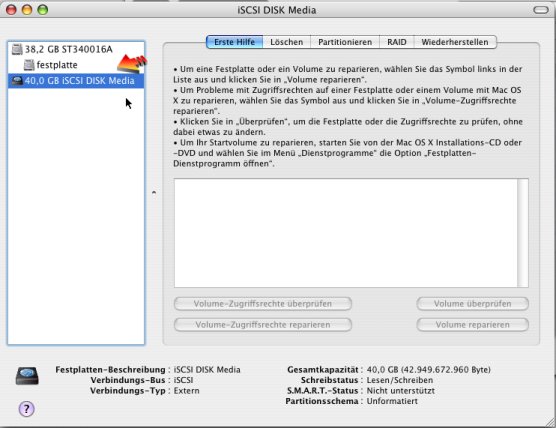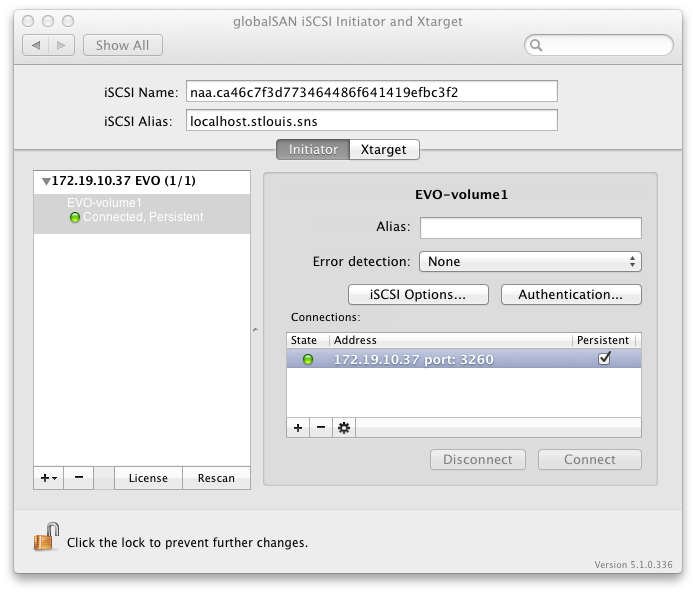
Iscsi Concept Of Iscsi Initiator X For Mac
St. Louis, MO, March 13, 2007 — Studio Network Solutions (SNS), a
premier developer and worldwide solutions provider of optimized
audio/video shared storage products, today announced that it has
advanced the state of the storage industry by making an iSCSI
initiator for Mac OS X available at no cost to the user.
The globalSAN® iSCSI Initiator enables Mac computers to connect to practically any iSCSI storage target, using standard GbE or 10GbE hardware. ISCSI is a network protocol standard that enables the transport of block-level I/O over TCP/IP. One major advantage of iSCSI is that it can work over your existing Ethernet infrastructure.
iSCSI is a network protocol standard that enables the transport of
block-level I/O over TCP/IP. When deployed over a Gigabit or
10-Gigabit Ethernet network, an iSCSI-based storage area network
(SAN) can rival the performance of a Fibre Channel SAN, while costing
far less to implement.
In an iSCSI SAN, an initiator is needed for each computer that
requires access to the networked storage. Although an initiator is
freely available for most major operating systems, an iSCSI initiator
is not shipped with Apple’s Mac OS X. Studio Network Solutions is
pleased to announce that version 3.0 of its globalSAN iSCSI initiator
for Mac OS X is now available for download from the company’s website.
“We’ve been shipping our Mac initiator with our SANmp sharing
software and globalSAN line of shared storage systems since 2004,”
stated Eric Newbauer, Director of Operations for Studio Network
Solutions. “We’ve focused on optimizing our iSCSI products so that
they perform very well under conditions where you’d normally expect
to need a Fibre Channel SAN. For example, our customers are using our
products with professional audio and video editing software like
Avid, Pro Tools and Final Cut Pro — these applications are extremely
dependent on high throughput and low latency.”
Version 3.0 of the globalSAN iSCSI initiator for OS X is a Universal
Application, for Intel- and PowerPC-based Mac computers. The
initiator supports CHAP, persistent targets, SLPv2 and Multiple
Connections per Session. This publicly available version is not a
timed evaluation or feature-locked — it is being offered for
download to any end-user who would like to take advantage of iSCSI in
an OS X-only, or a mixed operating system SAN environment.
SNS will be demonstrating its latest iSCSI and Fibre Channel products
at the upcoming NAB tradeshow in Las Vegas, April 14-19, location
SL4830. To learn more and to download the initiator, visit
(http://www.studionetworksolutions.com/).
About the Company
Usb serial converter model u209-000-r drivers for mac os. (http://www.studionetworksolutions.com/)
Studio Network Solutions (SNS) is a leading developer and provider of
optimized audio/video shared storage networks and workflow software
for the media and entertainment industries. The company develops
solutions for digital artists who work in post-production, recording
studios, broadcasting and corporate media production. Products
include SANmp — software for sharing iSCSI and Fibre Channel
storage; globalSAN — a turnkey iSCSI audio and video SAN; A/V SAN
PRO — custom Fibre Channel solutions; and Postmap — asset and
metadata management software.
For additional information please visit the company’s website.
There was only one choice we could find for a Mac iSCSI initiator. It is available from ATTO Technology. We used the iSCSI target we set up in this article, which is a GNU/Linux box running a 2.6 Linux kernel. Of course, iSCSI is a standard, so any iSCSI target should work as well. The install of the client is pretty easy. *Warning* The install appeared to delete some of our user profile settings like our mail and bookmarks, customized toolbar, stuff like that, so back up your home directory before you install it. Perhaps this was due to something else we did, but this happend the first reboot after the install. Enter the adminsitrator password when asked:
Click next a couple times to finish up the installation:
Start up the Xtend SAN application and enter the IP address of the target. There are no chap settings like there are with some other initiators, so you can’t set a password on the iSCSI target. Click discover, and the target should show up:
Click add and target status will show. If you want the drive to persist between reboots, choose auto login:
Mac OS X will now detect the drive and ask if you want to initialize it:
Here is the volume after we partitioned it:
The drive shows up like any other drive:
To make a backup of the system:
We don’t have the luxury of gigabit in our lab, so we used 100 Mbit. These settings worked much better than default over the slower connection:
Moom allows you to move and zoom windows - using either the mouse or the keyboard - to predefined locations and sizes, or to full screen mode. When used via the mouse, all you need to do is hover over a green resize button, and Moom's interface appears. When used via the keyboard, press your defined shortcut, and the Moom keyboard bezel appears; you can then move windows using the arrow keys. Moom 3.2.10 build 3215 get crack for mac.

Note that although we enabled CRC32C on HeaderDigest and DataDigest on the target, the initiator didn’t seem to enable it. Also, a note about stability. Before we tweaked the default settings the Mac OS X system would lock up hard. Granted, we are using a nonstandard, almost silly means of connection; however, do beware of the implications of having a device that the O/S expects to be hardware but isn’t. It is the beauty and downfall of iSCSI. This is a relatively new technology. The fact that the only real option for a Mac OS X initiator is the ATTO one shows how immature this technology is. Also, the target software is quite new as well, so it may be that the blame for the lockups with default settings can be shared by the target software.